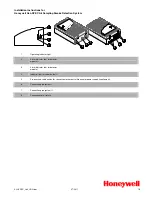
CONTENTS
Radio Basics . . . . . . . . . . . . . . . . . . . . . . . . . . . . . . . . . 1
The RF Waveband
1
The RF Network
1
RF Signal Characteristics
1
RF Signal Attenuation
2
Agile™ 200 Series RF Fire System . . . . . . . . . . . . . . . 3
The Concept of Mesh Hierarchy
3
Network Synchronisation
4
The Back-up Node
4
Site Survey . . . . . . . . . . . . . . . . . . . . . . . . . . . . . . . . . . 4
What is a Site Survey
4
Why is it Necessary
4
How to Plan a Site Survey
4
What to Take to a Site Survey
5
Summary of Basic RF Site Survey Principles
5
Some Guidelines for using the Agile™ 200 Series
Radio System . . . . . . . . . . . . . . . . . . . . . . . . . . . . . . . . 6
Agile™ System Coverage
6
Measuring Wall Attenuation
7
Not Able to Generate a Network
7
How to Resolve a Poor Link Quality
7
RF Do’s and Don’ts
8
Do’s 8
Don’ts 9
AGILE™ RADIO FIRE DETECTION SYSTEM
APPLICATION and INSTALLATION GUIDELINES
RF BASICS
The RF Waveband
Radio frequency (RF) devices use radio waves to communicate
(transmit and receive data) in the form of coded radio signals. The
RF waveband (part of the electromagnetic spectrum) ranges from
a few kHz to hundreds of GHz and can be divided up into different
sections, with different radio characteristics and capabilities.
The Agile™ 200 Series RF fire system uses a frequency range
based around 868MHz in the UHF region (the lower end of
microwaves); that is a wavelength of 346mm.
Short-range, low-power RF Systems are becoming more popular
for a wide range of applications; within fire and security products
they are often used in temporary installations or situations where
building work and unsightly cabling cannot be tolerated.
The RF Network
Agile™ 200 Series RF devices can transmit and receive, they are
transceivers. When two devices communicate directly with one
another, they have set up a link; the devices at each end of a link
are known as nodes. A set of devices (or nodes) communicating
together is called a network. There can be a wide range of network
topologies, as shown in the examples following:
VLF
LF
MF
HF
VHF UHF SHF EHF
IR
Visible light
10kHz
100kHz
1MHz
10MHz
100MHz
1GHz
10GHz
100GHz
1000GHz
System Sensor 200 Series RF
THF
Ring
Star
Fully
Connected
Line
Tree
Bus
Mesh
RF Signal Characteristics
Fundamentally radio signals, like light, travel in straight lines. And
in the same way as light they can be affected by objects in their
path. Forming part of the electromagnetic energy spectrum, they
are capable of transmission through some materials, absorption by
others and can be reflected, refracted and diffracted. The effects
on radio waves caused by different materials are dependent upon
the material’s properties.
Metallic surfaces are excellent reflectors of radio frequency
(RF) energy; water and wet areas may also be good reflectors.
Refraction occurs when electromagnetic waves pass across
a boundary between materials of different densities (refractive
index) and diffraction can occur when signals pass close to large,
particularly sharp, objects. Attenuation in different materials
(resulting from energy absorption and high frequency scattering)
is caused by the material’s molecular characteristics, structure and
resonances at different wavelengths.
In an open space, the power reduction down a signal path is
proportional to the square of the distance from the transmitter
(see
Figure 1 following)
.




























